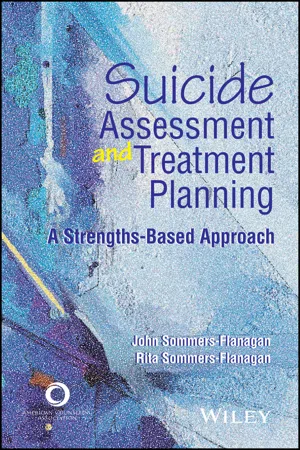
Suicide Assessment and Treatment Planning
A Strengths-Based Approach
- English
- ePUB (mobile friendly)
- Available on iOS & Android
Suicide Assessment and Treatment Planning
A Strengths-Based Approach
About this book
This practical guide provides a holistic, wellness-oriented approach to understanding suicide and working effectively with clients who are suicidal. John and Rita Sommers-Flanagans' culturally sensitive, seven-dimension model offers new ways to collaboratively integrate solution-focused and strengths-based strategies into clinical interactions and treatment planning with children, adolescents, and adults. Each chapter contains diverse case studies and key practitioner guidance points to deepen learning in addition to a wellness practice intervention to elevate mood. Personal and professional self-care and emotional preparation techniques are emphasized, as are ethical issues, counselor competencies, and clinically nuanced skill building.
*Requests for digital versions from ACA can be found on www.wiley.com
*To purchase print copies, please visit the ACA https://imis.counseling.org/store/
*Reproduction requests for material from books published by ACA should be directed to [email protected]
Frequently asked questions
- Essential is ideal for learners and professionals who enjoy exploring a wide range of subjects. Access the Essential Library with 800,000+ trusted titles and best-sellers across business, personal growth, and the humanities. Includes unlimited reading time and Standard Read Aloud voice.
- Complete: Perfect for advanced learners and researchers needing full, unrestricted access. Unlock 1.4M+ books across hundreds of subjects, including academic and specialized titles. The Complete Plan also includes advanced features like Premium Read Aloud and Research Assistant.
Please note we cannot support devices running on iOS 13 and Android 7 or earlier. Learn more about using the app.
Information
Chapter 1
Emotional Preparation
Your new Monday morning client shows up early for her 9 a.m. appointment. Her name is Alina. She is a 29-year-old lesbian woman. She lives alone, is unemployed, and complains that “life is impossible” without a partner. Alina is primarily of Croatian descent. Her family of origin lives about 500 miles away; Alina says she is glad to have distance from her family because “they’re all about judging me.”Alina talks about her chronic struggle with anxiety and depression and says, “I’m not sure anything can help me feel better.” She discloses that she wishes she could “go to sleep and not wake up.” You ask directly, “Have you had thoughts about suicide?” Alina admits to intermittent suicidality but denies an active plan. She says that even though she wants to stay alive, “thinking about suicide gives me a mental escape in case life gets worse.” Alina made a suicide attempt about 6 months ago using a combination of pills and alcohol. She ended up in the emergency department of her local hospital. She was glad to survive her attempt, which gives you hope about her motivation to live. After her suicide attempt, Alina was on antidepressant medications and had three counseling sessions, but she did not find either treatment helpful. She tells you she has heard you are a good counselor but that she would rather not take any medications.Although you are worried about Alina’s suicidality, you also feel positive about her openness and motivation to work in counseling. Before the session ends, you and Alina develop a safety plan, you get a signed release of information form so you can communicate with her physician, and you make a request for her previous treatment records. As she leaves, you feel confident about her short-term safety and her commitment to treatment, but she is a client you will be sure to think about during the week.
Getting Ready
Practical Realities
Table of contents
- Cover
- Table of Contents
- Title Page
- Copyright Page
- Dedication Page
- Preface
- About the Authors
- Acknowledgments
- Chapter 1: Emotional Preparation
- Chapter 2: Competence and Ethics
- Chapter 3: Suicide Assessment
- Chapter 4: The Emotional Dimension
- Chapter 5: The Cognitive Dimension
- Chapter 6: The Interpersonal Dimension
- Chapter 7: The Physical Dimension
- Chapter 8: The Cultural-Spiritual Dimension
- Chapter 9: The Behavioral Dimension
- Chapter 10: The Contextual Dimension
- References
- Index
- Technical Support
- End User License Agreement